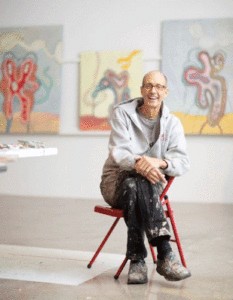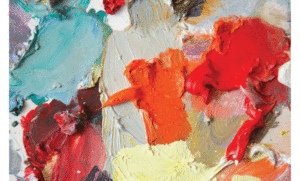 Large, bright creatures sprawl across Gatorfoam in the new series by former Columbus College of Art and Design president Denny Griffith. A little frisky, boldly erotic, and unapologetically joyful, the invented species in the paintings take on a world that is entirely their own. There are several paintings in the series, each one taking on a slightly cartoonish, fun approach with a playful Dali-like surrealism.
Large, bright creatures sprawl across Gatorfoam in the new series by former Columbus College of Art and Design president Denny Griffith. A little frisky, boldly erotic, and unapologetically joyful, the invented species in the paintings take on a world that is entirely their own. There are several paintings in the series, each one taking on a slightly cartoonish, fun approach with a playful Dali-like surrealism.
The series titled, Another World, may contrast Griffith’s life over the past two years. After 16 years as president of CCAD, Griffith announced his retirement at 63. The news hit the community he served hard, as he was deeply respected and admired. Less than a year later, Griffith was diagnosed with cholangiocarcinoma, a cancer that affects the bile ducts.
Forgoing retirement plans to move to North Carolina, following the devastating news, Griffith and his wife, Beth Fisher, were forced to regroup. They stayed in Columbus to be near Griffith’s treatments where Griffith already had a robust art studio. Instead of retreating from his art, Griffith set to work urgently producing 17-plus paintings. Many of the Gatorfoam boards reach an impressive 10 feet tall by 10 feet wide. The process for each painting calls for a layer of encaustic, which is heated in an electric griddle. Colors are added, then spread over a rigid, horizontal surface. Once the wax hardens, the Gatorfoam board is placed upright on an easel and painting with oil on wax can begin.
Even though Griffith acknowledged that his illness slowed him down, he diligently came into his studio nearly every day since the moment he announced his retirement. Griffith claimed the joy he experienced as a result of pushing through tough days overshadowed worries from the cancer. When the artist’s strength was sapped, he could still easily move the large compositions due to the lightweight quality of Gatorfoam. The material is also rigid and ideal for oil on top of encaustic, or beeswax.
It’s an important distinction to point out that Griffith started this body of work before the cancer diagnosis. While there may be some connection between the work and his illness, the paintings were not cancer paintings. Instead the paintings celebrated being alive.
The inspiration for Another World was planted during a trip to Chicago. It was a time when Griffith was looking forward to having more time for making art. He stumbled upon an earlier work of his hanging on the wall of a friend’s apartment and realized he was onto something. He always used beeswax, melted and imbued with color, and poured onto boards to create abstract shapes, but these earlier paintings had form and landscape. Overflowing with inspiration, Griffith returned home and grabbed a painting he had abandoned. He set to work on the old art with a cheap steam iron from Dollar General and flattened out all the wax to create a brand new surface to work on. His first piece turned out to be an alien form against a horizon. The rest of the series evolved from there.
Perhaps the best way to illustrate the impact Griffith has had on his community is to tune in with his prior students at CCAD. They credit the dedicated arts community leader with making Columbus an attractive place for an artist to make a living. Griffith also had a hand in taking CCAD from a tiny art school and shaped the program into an important part of the community by building up the role of design and increasing employment opportunities for graduates.
Griffith’s parting show, Another World, opened at Beeler Gallery on January 8th, less than two weeks later, the beloved former president of CCAD died following a two-year battle with cancer. In many ways his last exhibit was his most important work. It was a way for the artist to express without regard to his public position to CCAD. The public will have an opportunity to see the work at CCAD, Hammond Harkins Gallery near downtown Columbus, and later in Cincinnati at the Weston Gallery. A book was published by CCAD in conjunction with the show. Griffith made a huge impact on the arts community in Columbus throughout his 40-year career; it is not surprising the arts community rallied to show their support.
information courtesy of Columbus Monthly
photography courtesy of Will Shilling




